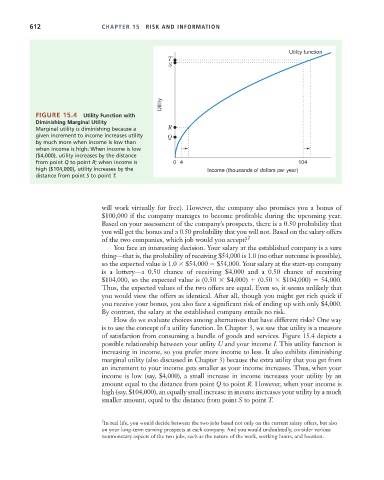Page 638 - Microeconomics, Fourth Edition
P. 638
c15riskandinformation.qxd 8/16/10 11:10 AM Page 612
612 CHAPTER 15 RISK AND INFORMATION
Utility function
T
S
Utility
FIGURE 15.4 Utility Function with
Diminishing Marginal Utility
Marginal utility is diminishing because a R
given increment to income increases utility Q
by much more when income is low than
when income is high: When income is low
($4,000), utility increases by the distance
from point Q to point R; when income is 0 4 104
high ($104,000), utility increases by the Income (thousands of dollars per year)
distance from point S to point T.
will work virtually for free). However, the company also promises you a bonus of
$100,000 if the company manages to become profitable during the upcoming year.
Based on your assessment of the company’s prospects, there is a 0.50 probability that
you will get the bonus and a 0.50 probability that you will not. Based on the salary offers
of the two companies, which job would you accept? 2
You face an interesting decision. Your salary at the established company is a sure
thing—that is, the probability of receiving $54,000 is 1.0 (no other outcome is possible),
so the expected value is 1.0 $54,000 $54,000. Your salary at the start-up company
is a lottery—a 0.50 chance of receiving $4,000 and a 0.50 chance of receiving
$104,000, so the expected value is (0.50 $4,000) (0.50 $104,000) 54,000.
Thus, the expected values of the two offers are equal. Even so, it seems unlikely that
you would view the offers as identical. After all, though you might get rich quick if
you receive your bonus, you also face a significant risk of ending up with only $4,000.
By contrast, the salary at the established company entails no risk.
How do we evaluate choices among alternatives that have different risks? One way
is to use the concept of a utility function. In Chapter 3, we saw that utility is a measure
of satisfaction from consuming a bundle of goods and services. Figure 15.4 depicts a
possible relationship between your utility U and your income I. This utility function is
increasing in income, so you prefer more income to less. It also exhibits diminishing
marginal utility (also discussed in Chapter 3) because the extra utility that you get from
an increment to your income gets smaller as your income increases. Thus, when your
income is low (say, $4,000), a small increase in income increases your utility by an
amount equal to the distance from point Q to point R. However, when your income is
high (say, $104,000), an equally small increase in income increases your utility by a much
smaller amount, equal to the distance from point S to point T.
2 In real life, you would decide between the two jobs based not only on the current salary offers, but also
on your long-term earning prospects at each company. And you would undoubtedly, consider various
nonmonetary aspects of the two jobs, such as the nature of the work, working hours, and location.

